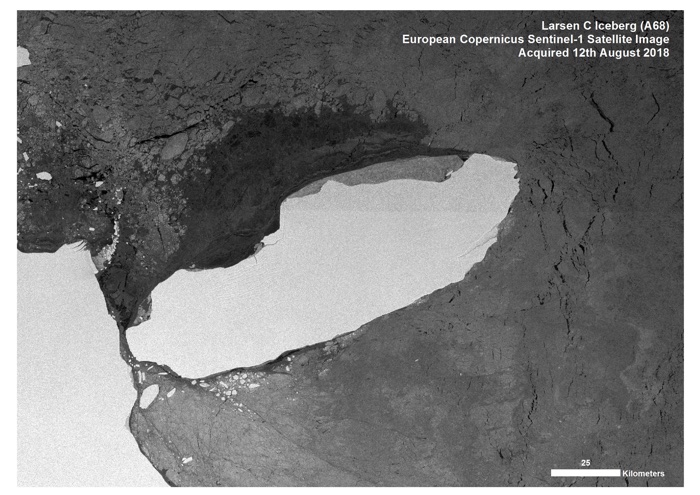For a year, not a lot happened. In July 2017, the world's sixth-largest iceberg on record tore free from its Antarctic moorings after months of dramatic anticipation, in which the world watched a gigantic chasm split the Larsen C ice shelf in two.
But then, this colossal broken shard of ice basically hunkered down. Satellite images revealed that over a year later, the iceberg – A68 – despite being buffeted by ocean currents, tides, and winds, was effectively grounded on the shallow seabed of the Bawden Ice Rise.
At least, it was until now.
After a long period of ice-bound inactivity, A68 has suddenly begun to drift again, with satellite imagery adjusted for brightness temperature (in purple) showing one edge of the giant iceberg swinging northwards in a movement that began in July this year, but which has rapidly picked up speed since then.
"You can see at between 7-12 July 2018 the weather conditions and ocean currents conspire to swing the trillion tonnes of the giant iceberg A68 in an anticlockwise direction," polar oceanographer Mark Brandon from the Open University in the UK explains on his blog.
What isn't for sure is where A68 is headed, or how far it might drift along its current trajectory. From his analysis of Sentinel-1 SAR satellite imagery, Brandon says that wind is pushing the sea ice to the north of the iceberg further north, and at a rate faster than A68's rotation.
If this keeps up, Brandon expects the iceberg to move into a vast patch of open water and young ice to the west of where A68 currently is, where ice slicks are forming in "intense" sea ice generation.
"My guess is that A68a will continue rotating as it is now around that western point, until what is currently the northern edge collides with the Larsen C ice front," Brandon writes.
"It has a spectacular amount of momentum and it's not going to [be] stopped easily."
 (British Antarctic Survey)
(British Antarctic Survey)
It's not clear at this point what caused A68 to make its sudden turn.
Readings from an automatic weather station operated by researchers from Utrecht University in the Netherlands show calm winds and unremarkable air temperatures in the period where the rotation began.
One strange blip in the data however is the stations's measurement of air pressure, which appears to show a patch of frenetic spikes lasting at least a week.
Brandon interprets this as an equipment malfunction producing bad readings.
"I know this doesn't tell us anything about the data, but it indicates the period was unusual compared with the rest of the year," he writes.
"Basically something odd was happening… What I do know is it takes a lot of energy to get a trillion tonnes of ice moving."
An alternative possibility is that gradual melting processes helped to shift the iceberg from where it was effectively anchored on the Bawden Ice Rise seabed.
"It might have been shaken loose by winds or ocean currents, or it might be that the natural thinning process (from both melting and the flow of the ice) has lifted the bottom of the iceberg off the seabed," glaciologist Martin O'Leary from Swansea University in the UK explained to Earther.
"In any case, it looks like the berg is now a lot more free to move about, so it will probably continue to rotate, and to move out to sea."
That's if the collision outcome does not result, of course.
Right now, nobody can tell for sure just what is going to happen to A68, which is so big, its massive footprint has variously been likened to the area of Delaware, half that of Jamaica, or a quarter of Wales.
Depending on what happens in the next weeks and months, A68's movement – and that of the sea ice surrounding the giant berg – could clear up space for researchers who desperately want to study the wintry underwater ecosystem revealed by the iceberg's cleaving, which scientists say has been trapped under ice for 120,000 years.
So far, their efforts have been defeated by the impenetrable ice that covers this inhospitable landscape.
As for what the future holds for those scientists and for A68 itself, it's currently unclear. But while we wait, all eyes are looking south.
